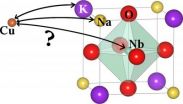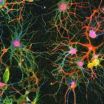Strike a pose: Research uncovers what's behind image in the modeling industry
2010-11-19
(Press-News.org) The casting sessions aren't just for movie stars, but what is involved in casting decisions that can launch fashion models to fame – or at the very least – to land a job? Stephanie Sadre-Orafai, a University of Cincinnati assistant professor and socio-cultural anthropologist, spent 11 months of fieldwork at a premiere casting agency in New York to uncover the decisions that happen behind the scenes of the glossy photos and slick commercials. Her research, "Polaroids and Go-Sees: Casting Encounters, Casting Epistemologies," was presented Nov. 17 at the 109th annual meeting of the American Anthropological Association in New Orleans.
Sadre-Orafai focused her research on face-to-face casting interviews at casting and modeling agencies in New York to explore how casting agents consider race, the transformation of appearance, balancing fantasy and truth, and selling an image, plus how that process affects the broader American culture's views on race and image.
"Functioning as intermediaries or brokers between modeling agencies and the clients that hire them, casting agents handle the logistical details of scheduling models' time and negotiating their rates, as well as provide an aesthetic direction and range of options within a client's requested specifications, typically described in terms of both 'strength' and 'diversity,'" explains Sadre-Orafai in her paper.
While their work is motivated by the aesthetic, their decisions are based on more than just a pretty face. "Through their photographic practices, casting agents differentiate themselves from their advertising and editorial clients," writes Sadre-Orafai. "Their documentary style produces bodily knowledge about models that is both diagnostic and predictive, which they use to assess models' suitability for other photographic contexts. Reading these images, however, ultimately requires their expertise and is based on their first-hand interactions with models, which most frequently occur through casting encounters," she says.
As the face-to-face meeting wrapped up, Sadre-Orafai says the agents took Polaroid photos and a series of digital images of four standard casting poses: the headshot, profile, torso and full-body. "Rather than a binding representation of a model, the casting images were starting points or tools agents used in conjunction with stories to try to re-create the multi-sensory dimensions of a casting interaction, with the ultimate goal of arranging a face-to-face meeting or call-back between the model and the client," she states in the paper.
Sadre-Orafai says that one of the surprising findings from the research was that many agents were critical of the fashion industry, as the agents felt that they struggled to not only balance fantasy and authenticity but also other fashion producers' ideas about race, as part of their work.
"Casting is about heightening, animating and eventually restaging face-to-face interactions with models," she concludes. "As such, these casting images are never meant to replace in-person assessments. Instead, agents use layouts with their stark documentary aesthetic as tools to present clients with a greater range and number of models than they can see directly. Casting agents also emphasize the need for discursive framing of these images."
INFORMATION: END
ELSE PRESS RELEASES FROM THIS DATE:
2010-11-19
HOUSTON – (Nov. 18, 2010) – Discovery of a fifth gene defect and the identification of 47 DNA regions linked to thoracic aortic disease are the subject of studies released this month involving researchers at The University of Texas Health Science Center at Houston (UTHealth).
In both studies, the investigators have identified alterations in the genetic material or DNA that affect the ability of smooth muscle cells, which line the aorta and other blood vessels, to contract. This can lead to a weakening of the wall of the aorta, the main blood vessel leading out of the ...
2010-11-19
Technical progress in the automobile industry is unbroken. But, the sector has still some hard nuts to crack: "Lead-free materials" is one of the challenges – hidden behind this challenge is a EU environmental directive which, based on a step-by-step plan, gradually bans all lead-containing materials and components from automotive vehicles – such as piezoelectric components. These elements are important for diesel engine injectors, for example, which control the supply of fuel to the combustion chamber.
The problem: Up to now lead-zirconate-titanate (PZT) is the material ...
2010-11-19
A short push on the light switch – and the whole ceiling lights up in a uniform and pleasant color. This "illuminated sky" is not available as yet, but researchers from all over the world are working on it flat out. The technology behind this marvel is based on organic light-emitting diodes, or OLEDs for short. These diodes use special molecules to emit light as soon as current passes through them. Although the first OLEDs have only recently become available, they are small and expensive. A flat disk with a diameter of eight centimeters costs around Euro 250. Experts of ...
2010-11-19
Scientists at Johns Hopkins have identified a compound that could be used to starve cancers of their sugar-based building blocks. The compound, called a glutaminase inhibitor, has been tested on laboratory-cultured, sugar-hungry brain cancer cells and, the scientists say, may have the potential to be used for many types of primary brain tumors.
The Johns Hopkins scientists, are inventors on patent applications related to the discovery, caution that glutaminase inhibitors have not been tested in animals or humans, but their findings may spark new interest in the glutaminase ...
2010-11-19
PHILADELPHIA – Cells have their own version of the cut-and-paste editing function called splicing. Researchers at the University of Pennsylvania School of Medicine have documented a novel form of splicing in the cytoplasm of a nerve cell, which dictates a special form of a potassium channel protein in the outer membrane. The channel protein is found in the dendrites of hippocampus cells -- the seat of memory, learning, and spatial navigation -- and is involved in coordinating the electrical firing of nerve cells. Dendrites, which branch from the cell body of the neuron, ...
2010-11-19
Montreal, November 18, 2010 – Schizophrenia is a mental disorder that differs between the sexes in terms of age at onset, symptomatology, response to medication, and structural brain abnormalities. Now, a new study from the Université de Montréal shows that there is gender difference between men and women's mental ability – with women performing better than men. These findings, published recently in, Schizophrenia Research, have implications for the more than 300 000 affected Canadians.
"We are the first to report sex differences in brain function of schizophrenics," ...
2010-11-19
The Soufriere Hills Volcano on Montserrat erupted in 1995, and an international team of researchers has studied this volcano from land and sea since then to understand the workings of andesite volcanos more completely.
"To the extent that the Soufriere Hills Volcano is typical of andesitic dome building volcanoes, results from this research can be expected to apply more generally," said Barry Voight, professor emeritus of geosciences, Penn State.
Voight and R. S. J. Sparks, the Channing Wills professor of geology, Bristol University, guest edited and introduced a special ...
2010-11-19
People who contract gastroenteritis from drinking water contaminated with E. coli are at an increased risk of developing high blood pressure, kidney problems and heart disease in later life, finds a study published on bmj.com today.
The findings underline the importance of ensuring a safe food and water supply and the need for regular monitoring for those affected.
It is estimated that E. coli O157:H7 infections cause up to 120,000 gastro-enteric illnesses annually in the US alone, resulting in over 2,000 hospitalisations and 60 deaths. However, the long term health ...
2010-11-19
Vitamin D is somewhat of an unusual "vitamin," because it can be made in the body from sunlight and most foods do not contain vitamin D unless added by fortification. Synthesis of vitamin D in the body requires exposure to ultraviolet light and can be influenced by genetics, skin color, and sun exposure. Reports of greater than expected vitamin D insufficiency coupled with emerging evidence that higher circulating concentrations of this nutrient may protect against cardiovascular disease have prompted a renewed interest in teasing out how environment, genetics, and behavior ...
2010-11-19
DURHAM, NC – Researchers have been stymied for years over the fact that people infected with the AIDS virus do indeed produce antibodies in response to the pathogen – antibodies that turn out to be ineffective in blocking infection.
Now, scientists at Duke University Medical Center can explain why: Some of the earliest and most abundant antibodies available to fight HIV can't actually "see" the virus until after it's already invaded a healthy cell.
The scientists based their conclusion on the results of a series of crystallography and biochemical experiments that revealed ...
LAST 30 PRESS RELEASES:
[Press-News.org] Strike a pose: Research uncovers what's behind image in the modeling industry



